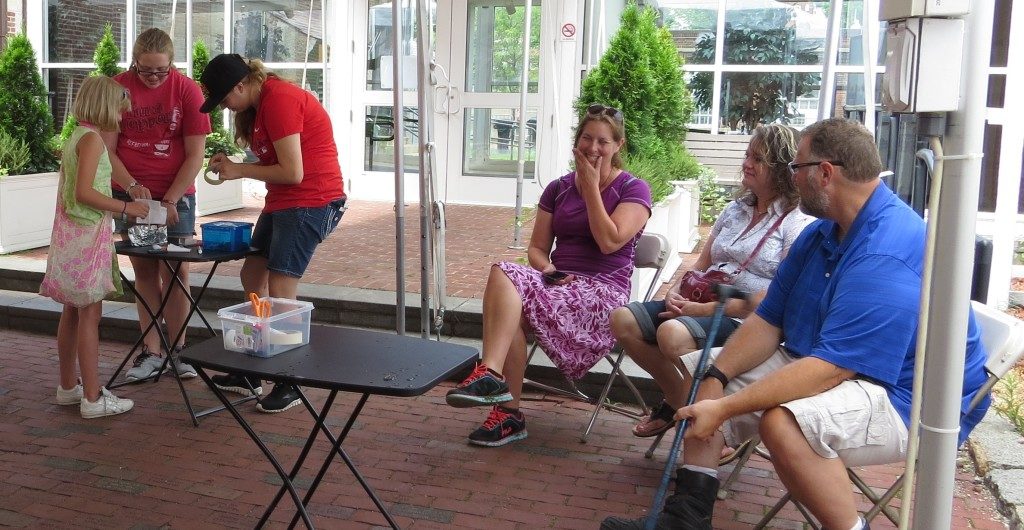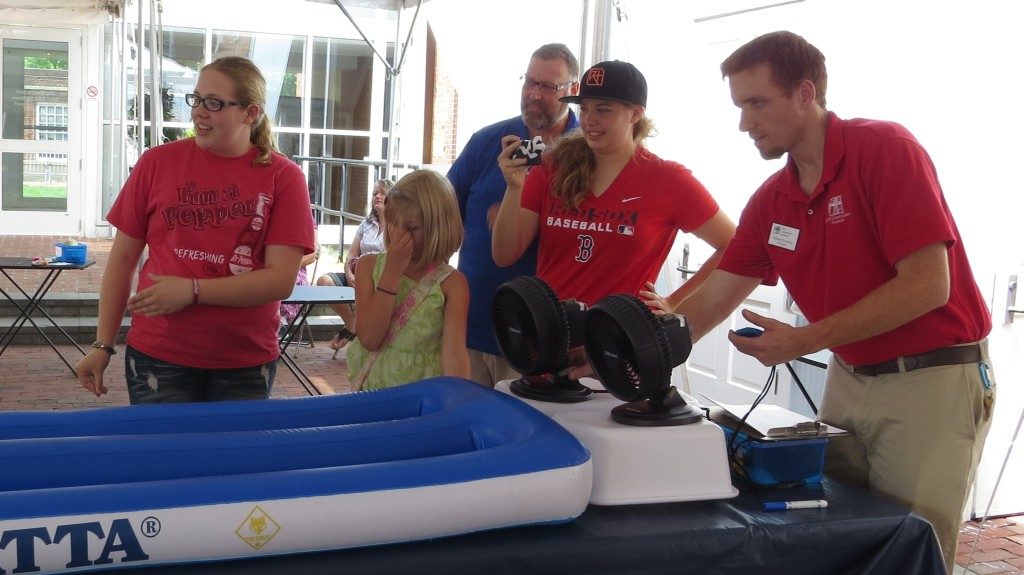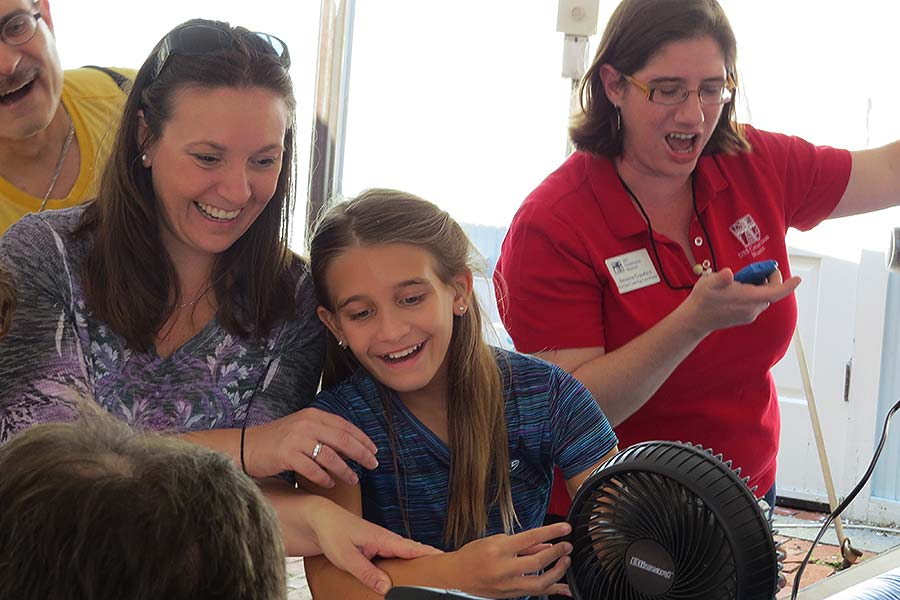As Beverly Sheppard explains, it’s about being responsive to the family visitors in order to facilitate the learning experience in a way that best suits them:
5 Strategies for Maximizing Engagement
Facilitators can use their skills to maximize participation across the family. It’s not just how many people can do something at one time. It’s about how many people can work together to accomplish a goal, have fun, make memories, participate together, and learn about each other.
1. Be the “Guide on the Side”
According to Marianna Adams, too often facilitators feel the need to impart knowledge to program participants by acting like a “sage on the stage.” It is far more difficult, she explains, to be an effective “guide on the side,” who works with family members to make connections and guide their experiences.
Beverly Sheppard describes the facilitator’s role as a partner to the family, one who uses facilitation tools to bring the program and the family together, but also knows when to step aside:
2. Modeling and Scaffolding
Not every parent is comfortable engaging with and teaching their children. The facilitator can assist by modeling teaching behaviors. By asking appropriate questions, encouraging reflection, and working successfully with a child, you are modeling behaviors that promote learning for the child’s adult caregiver. You can also point out to the parent what you are doing and why so that they can try to emulate your behavior with their children during the program and in the future.
Another facilitation technique that maximizes family engagement is scaffolding.1 At the USS Constitution Museum, facilitators often scaffold questions. In our Ready, Aim, Fire! gallery program, families need to understand how a cannon works so that they can build their own. Instead of asking that question- “How does a cannon work?”- facilitators ask a series of questions that build off of one another to scaffold this knowledge. Multiple questions about component parts of the cannon are less intimidating and build a greater understanding of the concept itself.
3. Make Learning Visible
When you see a child doing something that denotes learning or skill-building, point it out to the parent. He or she may not recognize the activity as a learning behavior: “Mary is using the scientific method and her critical thinking skills to hypothesize what will happen and then test her hypothesis.” These types of comments reinforce the child’s learning and help parents recognize it in action.
4. (Re) Engage During Transitions
A transition period is a good time to engage the disengaged. Ask a question, extend an invitation, or take the opportunity to insert disengaged participants into the next phase of the program. During the USS Constitution Museum’s Ready, Aim, Fire! cannon-firing program, we transition from the reproduction cannon to the gun crew tables. We take the opportunity to invite those family members not currently engaged to join their family at a table and then we ask everyone to take a guess at how many sailors it took to fire a cannon. We ask everyone to answer this question, even adults standing back, taking photos, or otherwise removed from the action.

In the USS Constitution Museum program Built to Win, the shift from building the model boat (above) to trying it out in the water (below) is a good opportunity to invite disengaged individuals to come over and watch.

5. Respect Family Visitors
It is important to have empathy and respect for family visitors. It takes a lot of work for a family to prepare an outing. Instead of judging an adult who is on the phone, show gratitude that the family came to visit. Facilitators are the face of this respect, empathy, and gratitude. The relationship they build with family audiences sends a message to visitors. And we want families to know that we are so glad they came to visit.
Flexibility and Preparedness
Facilitators should be prepared to cut short, expand, or change a program for visitors of varying abilities, ages, and cultures. Develop plans in advance. This helps facilitators feel comfortable making on-the-fly decisions that alter a program to suit the needs of any audience. At the USS Constitution Museum, our Ready, Aim, Fire! program is designed for a four-person gun crew, but simple options for larger and smaller families are already in place so that facilitators can quickly and confidently accommodate any family.
Some families might be interested in advanced content, further resources, or another challenge to complete, so be prepared with additional possibilities in your back pocket. Being flexible means you have a greater chance of maximizing the engagement of these family audiences. In our Built to Win program for instance, facilitators add timed races for complexity and an added challenge.
Potential Interruptions
Use these strategies to avoid potential interruptions to engagement:
- Latecomers: Perhaps you have a family member who comes in after everyone else got started. Latecomers don’t have to interrupt your program. Ask a child in their family to fill them in on the challenge. It makes the child articulate the goal of the program, which is good for the child and helpful for others to hear again. Plus, it encourages the adult to get involved.
- Younger Siblings: Families often come with little ones. They can be a distraction to one or more family members, especially adults, if there’s nothing for them to do. Have a related project ready for these youngest family members. For our model boat building program, we have toy plastic boats little ones can put in the water tank to play with. We also encourage those old enough to color to decorate the boat’s sail with markers.
Let Families Have Agency
As we discussed in the Accessible Design page, family members know each other best. They want, sometimes need, to make their own choices that best suit their familial needs and pre-existing relationships. To learn more about role negotiation and developing a relationship with families, visit the Establish Engagement page.
Know When to Step Away
In the USS Constitution Museum’s programming, we aim to design and set up a program that gets families working together. Our facilitators serve an essential role ensuring the success of that family engagement, but there are also situations within the program where we want to see families working with each other independently. For us, this balance is a sign of success and an important reminder to be a guide on the side.
